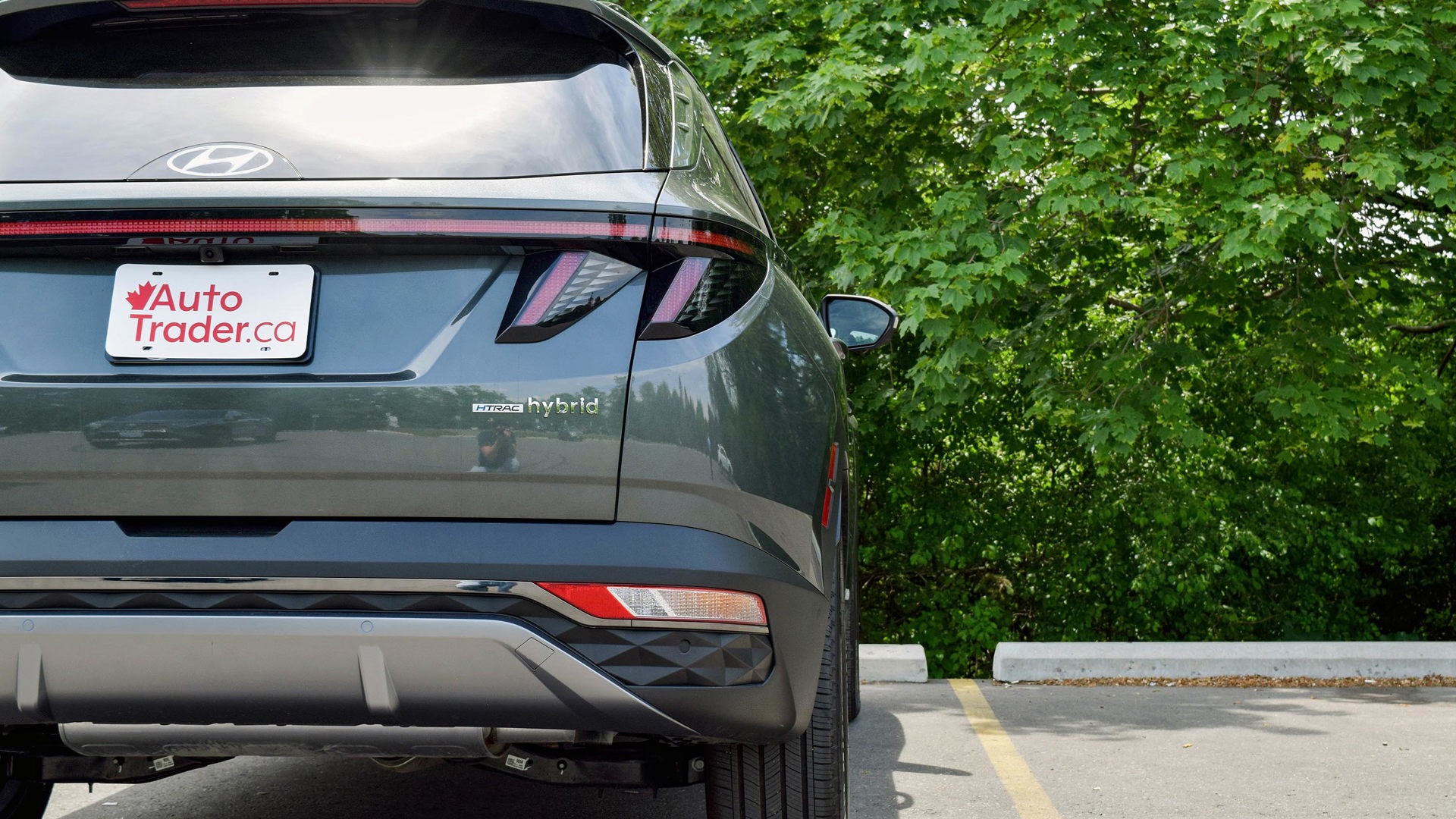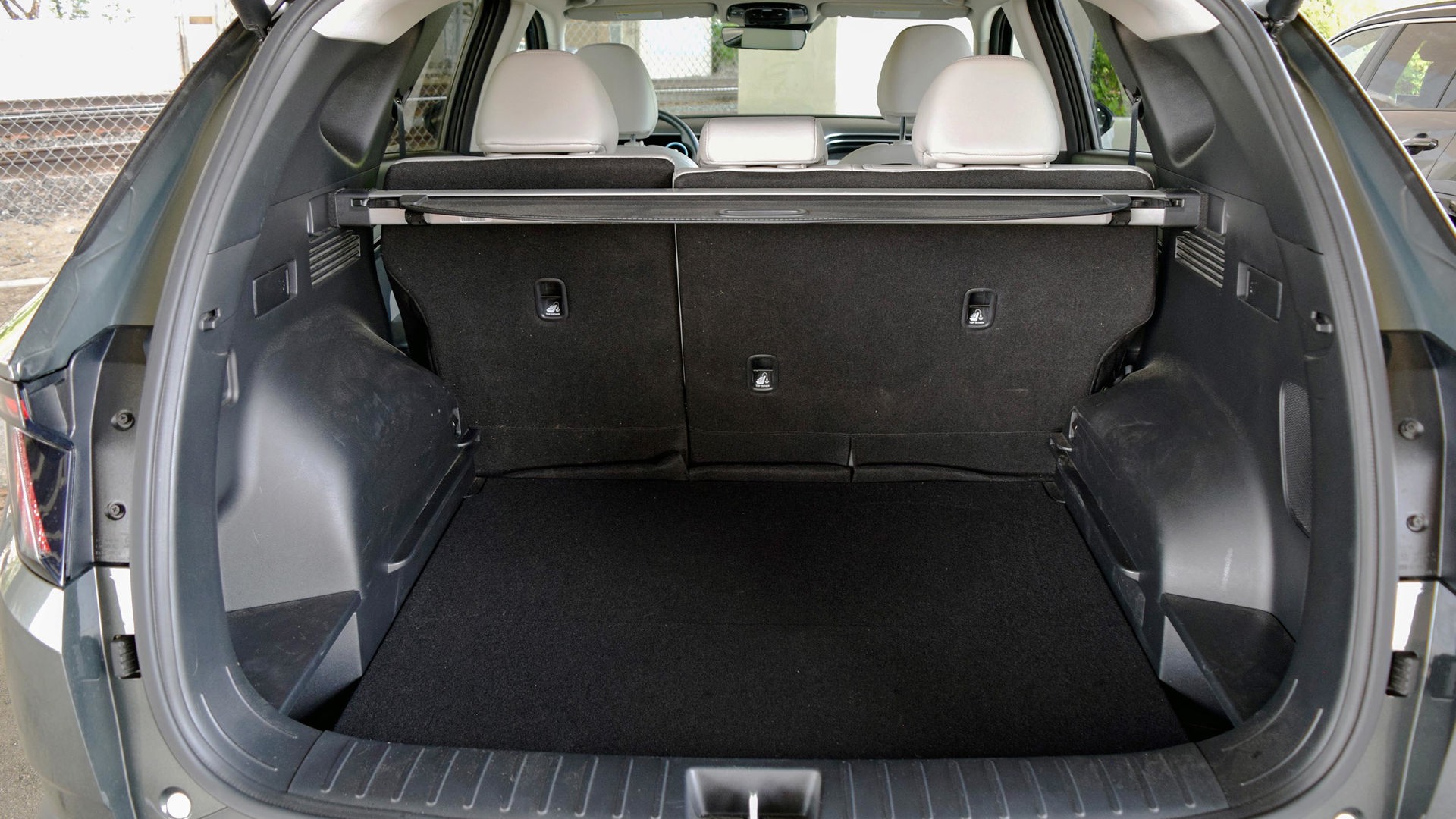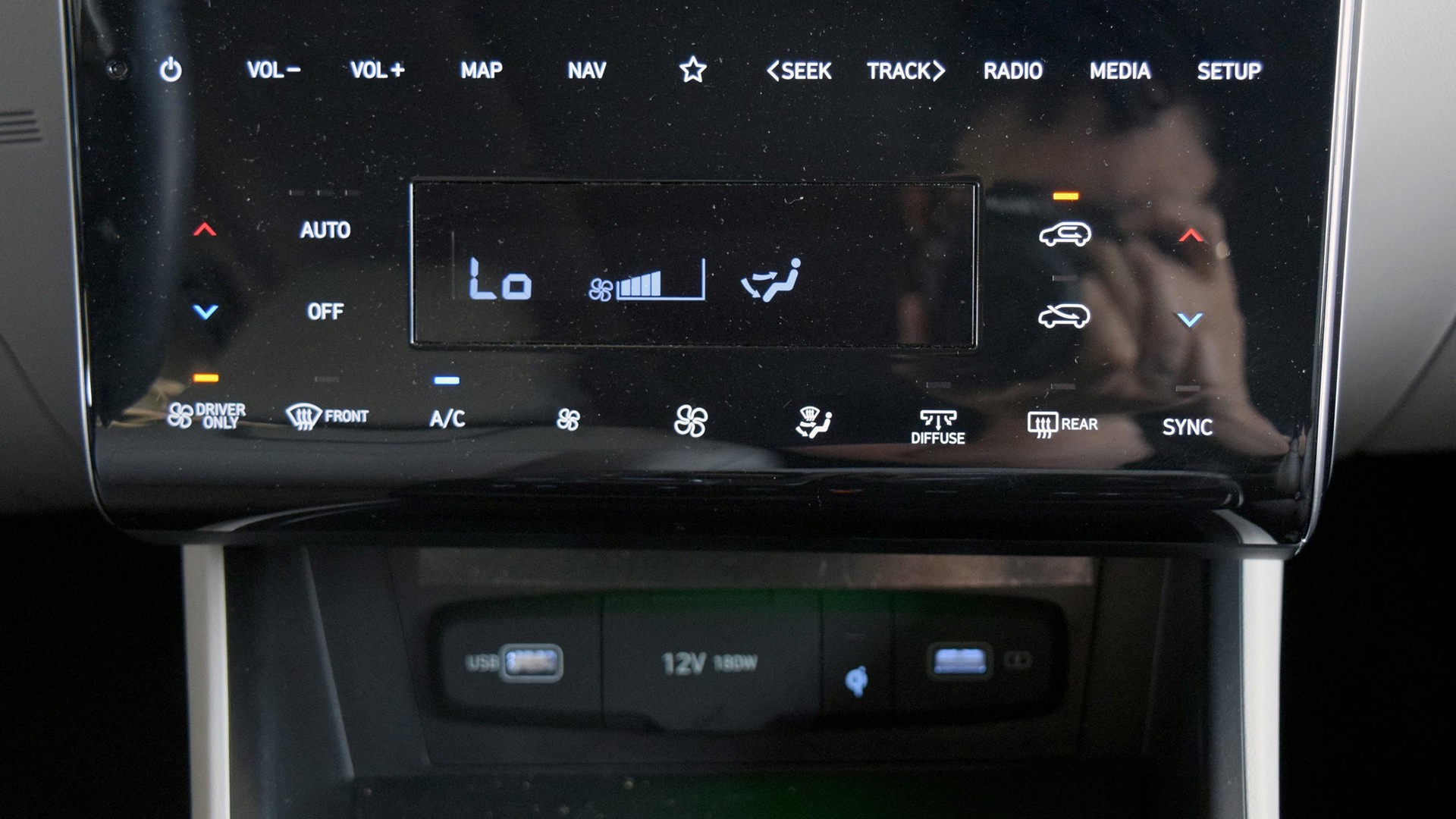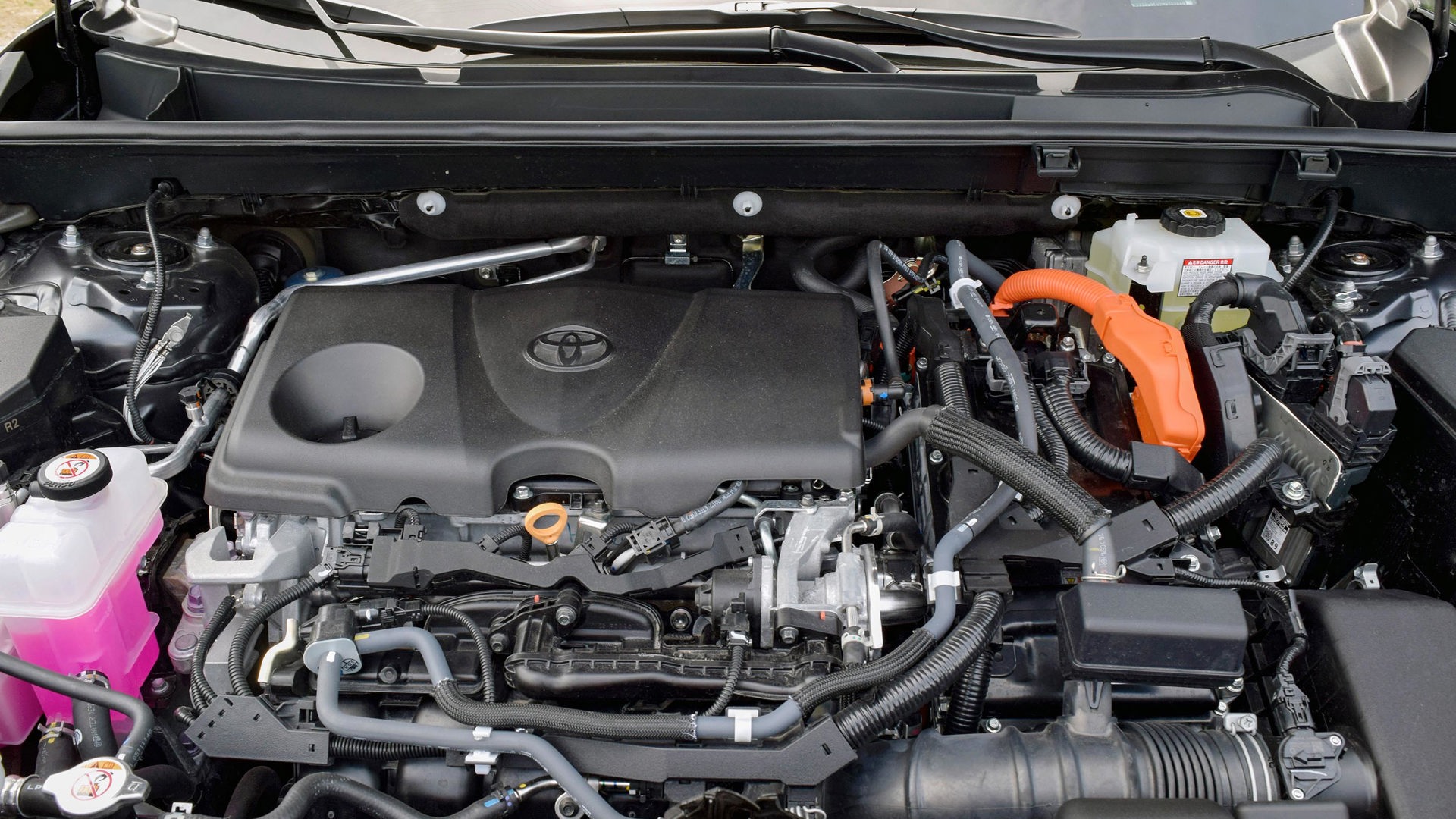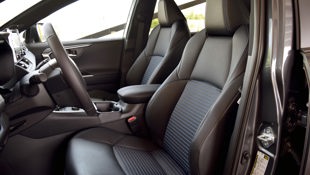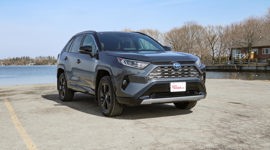Comparison Data
|
2022 Hyundai Tucson Ultimate
|
2021 Toyota RAV4 Hybrid XSE
|
|---|---|
|
Engine Displacement
1.6L
|
2.5L
|
|
Engine Cylinders
I4 hybrid
|
I4 hybrid
|
|
Peak Horsepower
227 hp
|
219 hp
|
|
Peak Torque
258 lb-ft
|
n/a
|
|
Fuel Economy
6.3 / 6.6 / 6.4 L/100 km cty/hwy/cmb
|
5.8 / 6.3 / 6.0 L/100 km cty/hwy/cmb
|
|
Cargo Space
1,097 / 2,108 L seats down
|
1,059 / 1,977 L seats down
|
|
Base Price
$41,499
|
$39,340
|
|
A/C Tax
$100
|
$100
|
|
Destination Fee
$1,825
|
$1,860
|
|
Price as Tested
$43,624
|
$44,130
|
|
Optional Equipment
$200 – Paint, $200
|
$2,830 – Technology Package, $2,830
|
If any automaker is worthy of credit for hybrids going mainstream it’s Toyota, which arrived early on the scene with the Prius and continues to pile on with more gas–electric models, such as the 2021 Toyota RAV4 Hybrid in this review.
But just because the brand got a head start doesn’t always mean it’s the only choice – nor is it always the best one. Hyundai has been busy adding efficient models to its own lineup, including the 2022 Hyundai Tucson Hybrid. Not only does this compact crossover match up well with the segment-leading Toyota but it provides some much-needed competition where it’s severely lacking.
Styling
The design team at Hyundai has worked hard to create vehicles that don’t fit in but rather stand out. You can’t help but stare at the redesigned Tucson, as its various exterior design cues excite the eyes. Up front, the lights are cleverly integrated with the grille, while the taillights have an aggressive, downward angle. As enticing as those elements are, the side profile is the most polarizing thanks to the various intersections of harsh lines and creases. To some, it looks edgy and cool, but it can also look like it’s been crumpled.
Inside, the cabin doesn’t reflect the wild exterior. In fact, it’s all pretty mundane and bland. That’s typically a compliment, as a minimalist design won’t interfere with the usability of the vehicle, but the application of many touch-sensitive switches makes the vehicle a bit frustrating to use.
We’ve griped about not having a volume knob or other physical buttons in the past, and the Tucson gets the same treatment. This is a case of style over substance. The rest of the cabin is fitted with a mix of materials that range from average to below-average feeling. A few too many plastics lead to uncomfortable rattles and squeaks and make the cabin feel a bit underwhelming.
The Toyota RAV4 Hybrid may look less modern, but its squared-off design provides a rugged aura that borrows heavily from the automaker’s long history of unstoppable trucks and SUVs. The large grille, squared-off profile, and chunky fender flares look the part of a tough trucklet. It may not be as memorable as the Tucson, but that could also be a result of the overwhelming popularity of the vehicle, which is the best-selling vehicle in Canada that isn’t a pickup truck.
Like Hyundai, Toyota didn’t overdo it with this interior, but there’s an appreciated distinction here. Rubberized knobs are easy to use even with gloves on or when the vehicle is in motion. The same material is found in other parts of the cabin and it may look a bit cheap, but it feels soft. Small buttons surround the infotainment system and HVAC controls, while larger buttons are found near the driver for easy access to various features and functions. This asymmetry is a bit odd in terms of a cohesive design, but it works all the same. The seats in our XSE tester aren’t completely leather-clad, and the majority of them feature a ribbed cloth material, which is comfortable although far from upscale.
Tucson Hybrid: 8/10; RAV4 Hybrid: 8/10
Safety
These two crossovers aren’t just fuel-efficient and stylish, but they’re safe, too. The Tucson arrives with a standard forward collision warning that can detect pedestrians and cyclists, a lane-keeping assist, driver attention warning, automatic high-beams, and a rear occupant alert, ensuring you won’t leave anyone – or anything – behind. And because the hybrid powertrain is only offered with the top two trims, it also includes an adaptive cruise control system, blind-spot monitoring, parking sensors, and a remote parking feature that allows you to get out and park the vehicle in a tight spot.
The driving assists work together to reduce the strain of long highway drives by following the lane of travel, accelerating when traffic allows, and even slowing for a highway off-ramp. While the last-generation Tucson was rated a Top Safety Pick by the Insurance Institute for Highway Safety (IIHS), the current model has yet to be tested.
The RAV4 also features a ton of safety gear and driver assists. Forward-collision warning, lane-departure warning and keep-assist, automatic high-beam headlights, and full-speed adaptive cruise control. Also standard on the hybrid RAV4 is blind-spot monitoring, while the only safety equipment reserved for the top trim are the surround-view camera, parking sensors, and automatic rear cross-traffic braking. The RAV4 is an IIHS Top Safety Pick.
Tucson Hybrid: 8/10; RAV4 Hybrid: 8.5/10
Features
There are two trim levels of the Tucson Hybrid – Luxury and Ultimate – compared to four RAV4 Hybrid models: LE, XLE, XSE, and Limited. Standard equipment beyond the safety features on the RAV4 LE includes heated front seats, dual-zone climate control, and a seven-inch touchscreen that includes support for Apple CarPlay and Android Auto. You have to opt for the higher trim XLE or XSE models to get a heated steering wheel, power tailgate, rain-sensing wipers, push-button start, and a cargo cover, while fully loaded Limited models add ventilated front seats, heated rear seats, a digital rearview mirror, wireless phone charger, kick sensor for the tailgate, eight-inch touchscreen with navigation, and an upgraded sound system. Some of these features are also available through an optional package for the XSE, allowing customers to combine the aggressive looks of this trim with the equipment of the top model.
Since the Tucson Hybrid is only offered in the two highest trim levels it appears as the better-equipped of the two – but then it’s priced higher to start. The Tucson Hybrid gets rain-sensing wipers, push-button start, remote start, leather seats, heated and ventilated front seats, heated rear seats, colourful ambient lighting, a 10.25-inch digital display cluster, a heated steering wheel, dual-zone climate control, a large panoramic sunroof, a wireless phone charger, and an eight-inch touchscreen infotainment system with Apple CarPlay and Android Auto support. The fully decked out Ultimate trim model gets a larger infotainment system with navigation, memory seats, additional ambient lighting, and power-adjustable passenger seats.
Tucson Hybrid: 9/10; RAV4 Hybrid: 8/10
User Friendliness
With simple controls like physical buttons and knobs, the Toyota is easier to use and get accustomed to. Gear selection is done with a traditional selector, while drive modes can be adjusted with a knob on the centre console. The only notable absence is the inability to fold the rear seats from the cargo area, while the touchscreen infotainment system is a bit slow and not the most glamorous system around.
The touch-focused interface of the Tucson Hybrid can be a headache at times – especially since basic functions like increasing the radio volume or changing the HVAC settings require multiple taps rather than the twist of a knob. And while the infotainment system is quick and detailed, it starts up with a bland home screen that’s like a phone’s lock screen. Finally, when using Android Auto or Apple CarPlay only a portion of the large display from the top trim is utilized, which feels like a waste of screen space. That’s particularly disappointing given the Kia Seltos uses the full screen when a phone is connected to its display of the same size.
Tucson Hybrid: 7/10; RAV4 Hybrid: 8/10
Practicality
You’ll find 1,097 L of storage capacity behind the rear seats of the Tucson Hybrid, while the space grows to a total of 2,108 L with the seats folded. Hyundai allows you to flip those seats down using some handy levers in the cargo area, and also provides a moveable cargo floor which can provide a flat load surface when the rear seats are folded, or additional storage when they’re up.
The RAV4 features marginally less space on paper, with 1,059 L behind the rear seats and 1,977 L when they’re folded. The Toyota manages to provide a bit more rear headroom than the Tucson but is on par or behind the Hyundai in other interior measurements.
Tucson Hybrid: 8.5/10; RAV4 Hybrid: 7.5/10
Comfort
Assessing comfort in these vehicles is easy as they’re both cozy. Aside from the limited places around the cabin that use hard plastics, both the RAV4 and Tucson feature cabins that are designed to be comfortable for long drives.
Ride comfort is also good. The RAV4 rides a bit more smoothly on the road, but the Tucson never felt jarring. Both suffer the same troubles with road noise, however. While operating on electric power alone, the vehicles are super quiet, but if you need to quickly make a pass the gas motors kick in and rev pretty high, and the experience can be a bit unrefined. The Tucson fared slightly worse in these situations during testing.
Tucson Hybrid: 7.5/10; RAV4 Hybrid: 8.5/10
Power
That noise complaint makes sense when you compare their powerplants. Under the hood of the Tucson is a 1.6L turbocharged four-cylinder engine that makes 180 hp and 195 lb-ft of torque. That engine works in unison with a 44.2-kW electric motor, delivering a combined 227 hp and 258 lb-ft of torque. The vehicle features all-wheel drive, but Hyundai uses a six-speed automatic transmission in its hybrids compared to an eight-speed auto in its gas-powered Tucson models. It also uses a mechanical all-wheel drive system like the Ford Escape Hybrid. Perhaps due to the turbo motor or the limited gear ratios, the Tucson doesn’t feel as refined as the RAV4 in most conditions, and the shift from electric power to gas operation was slow and clunky on occasion during testing.
Toyota showcases its experience working on hybrids, as the RAV4 Hybrid feels far more refined. Under the hood of this crossover is a 2.5L four-cylinder engine making 176 hp and 163 lb-ft of torque. The RAV4 has a pair of electric motors: one working up front in unison with the gas engine, and another powering the rear wheels. The combined output is 219 hp, and that’s managed through a continuously variable transmission (CVT). While the RAV4 puts out less combined horsepower, the way the transmission manages the powertrain is far more responsive and refined.
Tucson Hybrid: 7.5/10; RAV4 Hybrid: 8.5/10
Driving Feel
Both Hyundai and Toyota have gone to great lengths to ensure their crossovers drive as the pilot intends. You’ll find limited body roll in both vehicles, and despite their utility-first focus, they feel relatively agile. The Tucson feels a bit more engaging to drive, though the stiff chassis in the RAV4 is commendable, too. Steering feel is perhaps the biggest factor separating these two vehicles; where the Toyota can feel a bit light and numb at times, the Hyundai is a bit heavier and more reassuring.
Tucson Hybrid: 7.5/10; RAV4 Hybrid: 7/10
Fuel Economy
When it comes to hybrids, though, fuel economy is a big factor. The Tucson is rated to return 6.3 L/100 km in city driving conditions, 6.6 on the highway, and a combined 6.4. The RAV4 Hybrid does a bit better, returning 5.8 L/100 km in city driving conditions, 6.3 on the highway, and a combined 6.0. As if those numbers aren’t impressive enough, the RAV4 easily met or improved upon those numbers, while it was a slow-going hassle in the Tucson Hybrid to even meet those estimates – though AutoTrader.ca Road Test Editor Dan Ilika bested them during an earlier evaluation.
Tucson Hybrid: 7.5/10; RAV4 Hybrid: 9.5/10
Value
Getting a Tucson Hybrid means you’re starting with the Luxury trim, which costs $40,624 when you include the $1,825 delivery and destination fee. While it comes with a lot of features, those looking for the fully loaded experience will be spending $43,324 including destination and delivery. Our model also featured a $200 paint finish.
The RAV4 Hybrid has a greater range of trims, so you can get a fairly basic LE model for $34,810 including the $1,860 freight and delivery fee. The XLE model is an extra $3,000, with a $37,810 asking price, while the XSE model costs $3,390 more at $41,200. We tested an XSE with the $2,830 Technology Package, but there is a tricked-out Limited model for $45,210.
While the RAV4 Hybrid is more affordable than the Tucson Hybrid, the Hyundai comes with more equipment. Even at the top trims, the Tucson is still more affordable and still comes with more equipment.
Tucson Hybrid: 8/10; RAV4 Hybrid: 7.5/10
The Verdict
Well-equipped and aggressively priced, the stylish 2022 Hyundai Tucson Hybrid is hard to turn down. However, you can get all those aspects with a non-hybrid model. When it comes to pure fuel economy and an impressive cooperation of gas and electric power plants, the 2021 Toyota RAV4 Hybrid is still the best choice as a fuel-efficient gas–electric crossover.











